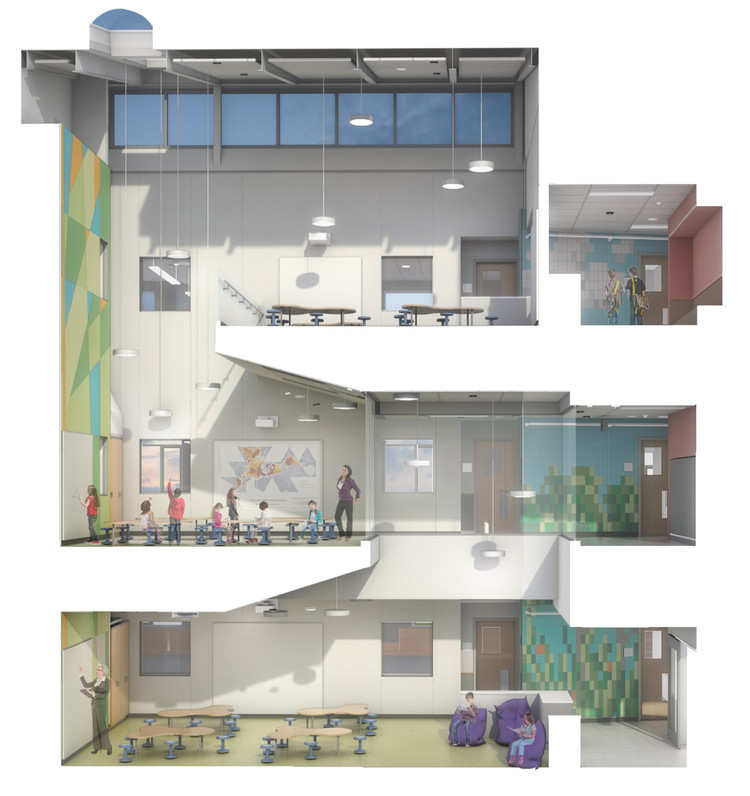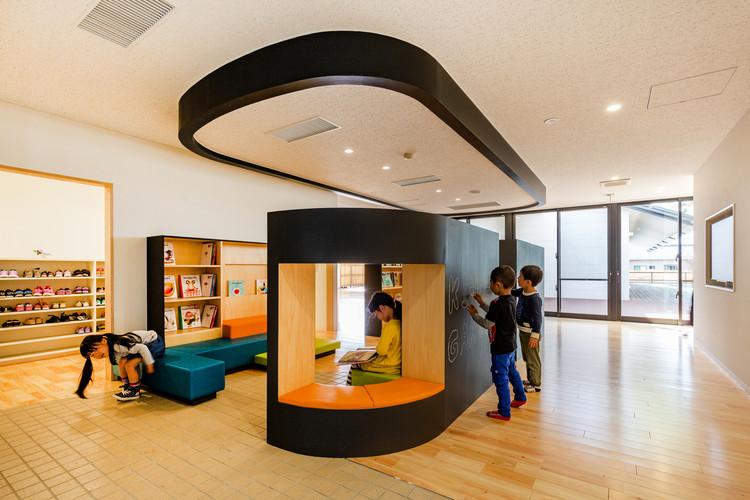
It is a student's right to be educated in a safe, healthy, and even aesthetically appealing environment, especially young students for whom these factors are even more important. For example, it has been shown that when the ergonomics of chairs are inadequate, they can greatly affect levels of concentration and the development of skills such as calligraphy. At the same time, the effectiveness of traditional teaching methods is increasingly being questioned and the quality of alternative methodologies increasingly being considered. In other articles, we discussed in more detail the design of Montessori schools and the atmosphere of Waldorf interiors.
Today, we will cover the importance of choosing furniture and address some aspects to consider when organizing them in classroom design for the schools of the future.
.jpg?1587937467)
For these and many other reasons, it is possible to say that there is a fundamental trilogy for successful learning: the qualifications of the teaching staff, the interest of the students, and the quality of the physical environment - the classroom. Among them, architecture has the ability to provide spaces of high environmental comfort, including functional design and quality furnishings.

When thinking about the configuration of classrooms of the future, it is necessary to consider five tips that will help meet the needs of students:
- Spaces for exercise and movements: it is important to provide free areas near or even within classrooms to meet this demand.
- Gym equipment: an area (this time with small gym equipment) can be provided to even better remedy the need for exercise or physical activity.
- Multipurpose tables: as in offices, students should be able to vary the use of the tables and adjust whether they can be accessed sitting or standing.
- Furniture with wheels: tables and chairs with wheels allow quick and quiet flexibility. We will talk about this benefit later.
- Spaces for the sharing of ideas: spaces for students to write and discuss ideas among themselves are essential.


Among the general concerns to consider when designing a learning space are:
- Flexibility: to support the most varied teaching and learning strategies.
- Efficiency: as in any designed environment, sustainable solutions must be well developed and the alternatives must be long-term. As the saying goes, cheap is expensive.
- Ergonomics: the user must be taken into account. Everything should be adapted to the measurements of the student (determined by standards for each age group) and consider the different levels of development of each phase of human life. For example, the amount of uninterrupted time for which a student is able to concentrate typically varies per age group:
- From 6 to 10 years old: on average, 5 minutes of concentration.
- From 11 to 15 years old: on average, 15 minutes of concentration.
- From 16 to 20 years old: on average, 25 minutes of concentration.
For this reason, it is important to design areas of movement that allow breaks without affecting the progress of classes. Dr. D. Breithecker (from the Federal Institute for Posture and Exercise Development in Wiesbaden) recommends that the school day be divided as follows: 50% sitting (dynamic session) / 30% standing (standing tables) / 20% movement (learning on the move).

Flexibility
In the past, the classroom only needed one type of setup: the teacher in front (sitting in a chair or writing on the board) and the students in parallel rows listening and taking notes. Increasingly, teaching styles have undergone intense transformations. The schools of the future must be flexible because in them, school routines are structured through blocks of rhythmic activities.
The new ways of organizing tables and chairs are part of this change, facilitating communication and democratizing the teaching environment. In 21st century schools, the focus is on the student, and to demonstrate this new commitment, design must accompany the transformation.

The furniture must be flexible to allow different options for spatial organization, ensuring that the arrangement of the space adapts easily to any activity proposed by the school curriculum quickly and quietly.

Some of the spatial possibilities that contribute to new teaching practices are:
- A large circle of chairs for discussions.
- Smaller groups for thematic discussions.
- Spaces for exclusive conversations with the teacher.
- Spaces for individual concentration. In this case, it may be useful to provide mobile partitions.
- Spaces to demonstrate the teacher's work. Here, new technology can provide dynamic and interactive whiteboards to capture student interest.

Thus, light and easy-to-move furniture has an advantage over traditional furniture, usually made of wood. Chairs with wheels are an excellent option because they are quiet and fast. Also, they have height and rotation adjustments, so they tend to be more successful than fixed ones, in which there is more discomfort for students who need to change positions regularly.
Efficiency
Each student spends an average of six hours a day (for approximately 11 years) sitting in school chairs. If we consider that when the students leave, new ones always arrive, it becomes clear that investment in high quality furniture is more effective than choosing cheaper, inferior quality pieces.
When choosing tables, chairs, and cabinets for school settings, their durability, ease of cleaning and maintenance, and strength must be taken into account. Often, when furniture is chosen, the architectural work is already finished and the budget is tight. To avoid a lack of funds when choosing school furniture, it is important to consider this investment from the beginning of the project.

The choice of quality furniture indicates to the user (in this case, the children) that there is concern for them. Therefore, it is very likely that better furniture can create a greater feeling of belonging, and consequently, encourage the children to have a greater respect for their environment.

Another recommendation for furniture is to consider the age group that each classroom will accommodate, so as to not risk picking generic furniture. Although such items might be high quality, they will be ineffective for certain age groups. The same applies to other school areas: the chairs used in classrooms should not be the same as those in the library, cafeteria, or science labs.

For the choice of tables, designers should consider that most students use electronic devices such as laptops or tablets. Thus, they should choose tables with surfaces that fit these devices, in addition to other basic materials such as notebooks and binders.

Ergonomics
A study carried out by FIRA (Furniture Industry Research Association) in the United Kingdom affirms that today's children are taller (with longer arms and legs) than they were thirty years ago. These are measures that directly influence comfort. In many schools today, these 21st century children continue to use furniture that was designed for children over 50 years ago.
The chosen furniture must be adapted to the dimensions of the children, and not the other way around. They must allow movement and ensure good posture.


The furniture of the schools of the future must reflect the needs of the children of the present. Far beyond aesthetics, the quality of the furniture (and its arrangement in interior spaces) improves development and, consequently, contributes to the best learning for students of any age. According to the same survey carried out by FIRA, 13% of students between 10 and 16 years old have some type of problem or discomfort in the posterior area. This number is even higher in older children. Choosing tables and chairs with a certain inclination can already forge a great step in solving this problem.
Benefits of a good choice of school furniture
For students
- Greater ease of learning, empowering students and increasing their self-esteem. Students will be able to focus more and complete tasks faster.
- Better quality of life, with correct ergonomics reducing health problems and promoting greater physical well-being.
- Greater creativity, thanks to the flexibility of space that will allow more stimuli when it comes to learning.
For teachers
- Support for a flexible curriculum. When the furniture foresees design changes, the teacher feels more comfortable proposing such changes, making the proposed activities more dynamic and attractive to students.
- The incentive to belong to the physical space pushes students to be more willing to collaborate, which makes the classroom more fun and comfortable for everyone.

For schools
- Choosing quality furniture requires a large investment in the short term, but provides very important benefits in the long term. Normally, each piece of furniture purchased should have a useful life of 10 years.
- Flexible design (and consequently flexible teaching) generates more interest from students and, in turn, better results. A stimulating work environment is desirable for everyone involved.
Choosing furniture that meets the needs of students is a positive choice for everyone involved in the school environment. Administrators and architects should change their perspective on furniture costs and consider investing in high quality pieces from the initial phase of the project. Architects should also take into account the parameters of efficiency, ergonomics, and flexibility explained above, putting children at the center of school design.
Therefore, in addition to providing spaces for free and guided movement, the school furniture of the future must be aligned with the needs of a more flexible didactic environment, which in turn must be durable and comfortable for all users.

References
- Safe seats of learning. How good school furniture can make a difference. Disponível neste link. Acesso 23 abril 2020.









.jpg?1587937467)










